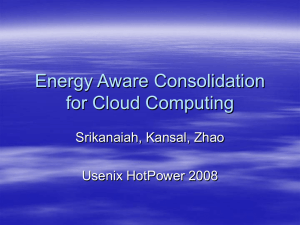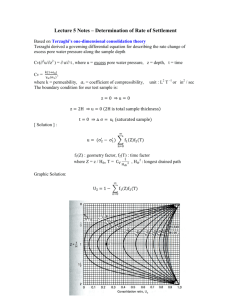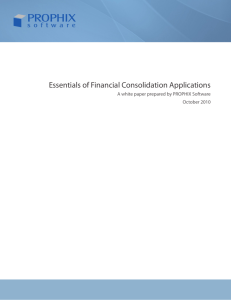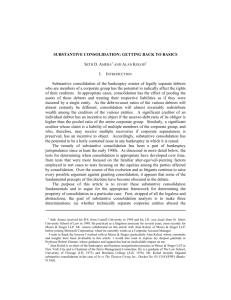Consolidation Business Strategy
advertisement
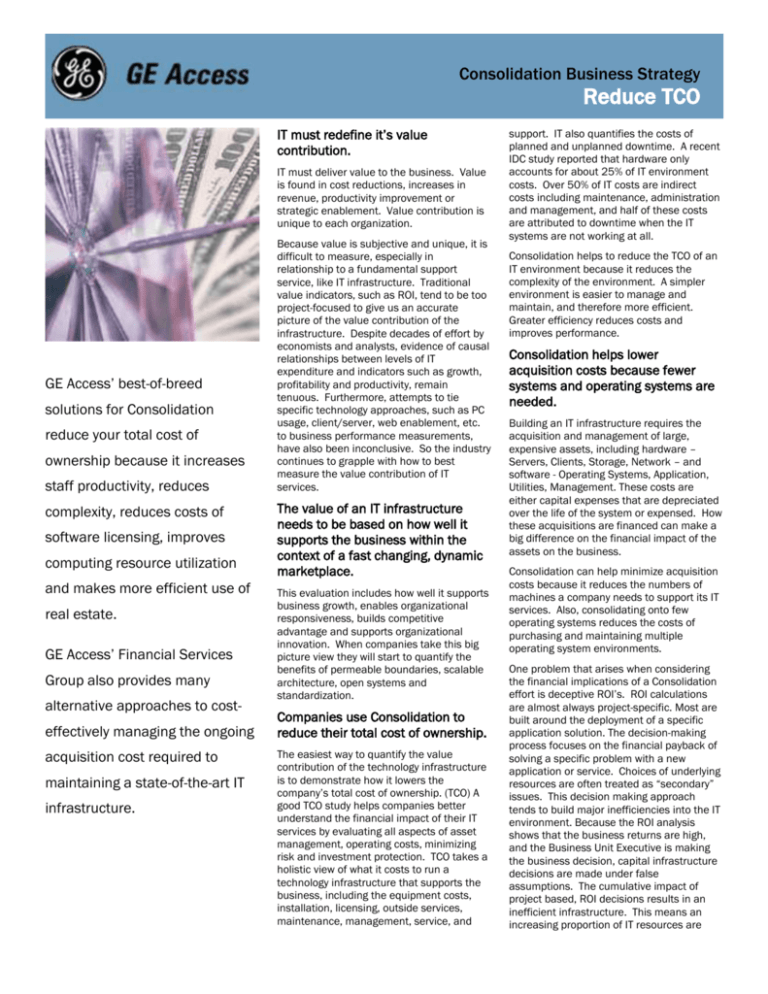
Consolidation Business Strategy Reduce TCO IT must redefine it’s value contribution. IT must deliver value to the business. Value is found in cost reductions, increases in revenue, productivity improvement or strategic enablement. Value contribution is unique to each organization. GE Access’ best-of-breed solutions for Consolidation reduce your total cost of ownership because it increases staff productivity, reduces complexity, reduces costs of software licensing, improves computing resource utilization and makes more efficient use of real estate. GE Access’ Financial Services Group also provides many alternative approaches to costeffectively managing the ongoing acquisition cost required to maintaining a state-of-the-art IT infrastructure. Because value is subjective and unique, it is difficult to measure, especially in relationship to a fundamental support service, like IT infrastructure. Traditional value indicators, such as ROI, tend to be too project-focused to give us an accurate picture of the value contribution of the infrastructure. Despite decades of effort by economists and analysts, evidence of causal relationships between levels of IT expenditure and indicators such as growth, profitability and productivity, remain tenuous. Furthermore, attempts to tie specific technology approaches, such as PC usage, client/server, web enablement, etc. to business performance measurements, have also been inconclusive. So the industry continues to grapple with how to best measure the value contribution of IT services. The value of an IT infrastructure needs to be based on how well it supports the business within the context of a fast changing, dynamic marketplace. This evaluation includes how well it supports business growth, enables organizational responsiveness, builds competitive advantage and supports organizational innovation. When companies take this big picture view they will start to quantify the benefits of permeable boundaries, scalable architecture, open systems and standardization. Companies use Consolidation to reduce their total cost of ownership. The easiest way to quantify the value contribution of the technology infrastructure is to demonstrate how it lowers the company’s total cost of ownership. (TCO) A good TCO study helps companies better understand the financial impact of their IT services by evaluating all aspects of asset management, operating costs, minimizing risk and investment protection. TCO takes a holistic view of what it costs to run a technology infrastructure that supports the business, including the equipment costs, installation, licensing, outside services, maintenance, management, service, and support. IT also quantifies the costs of planned and unplanned downtime. A recent IDC study reported that hardware only accounts for about 25% of IT environment costs. Over 50% of IT costs are indirect costs including maintenance, administration and management, and half of these costs are attributed to downtime when the IT systems are not working at all. Consolidation helps to reduce the TCO of an IT environment because it reduces the complexity of the environment. A simpler environment is easier to manage and maintain, and therefore more efficient. Greater efficiency reduces costs and improves performance. Consolidation helps lower acquisition costs because fewer systems and operating systems are needed. Building an IT infrastructure requires the acquisition and management of large, expensive assets, including hardware – Servers, Clients, Storage, Network – and software - Operating Systems, Application, Utilities, Management. These costs are either capital expenses that are depreciated over the life of the system or expensed. How these acquisitions are financed can make a big difference on the financial impact of the assets on the business. Consolidation can help minimize acquisition costs because it reduces the numbers of machines a company needs to support its IT services. Also, consolidating onto few operating systems reduces the costs of purchasing and maintaining multiple operating system environments. One problem that arises when considering the financial implications of a Consolidation effort is deceptive ROI’s. ROI calculations are almost always project-specific. Most are built around the deployment of a specific application solution. The decision-making process focuses on the financial payback of solving a specific problem with a new application or service. Choices of underlying resources are often treated as “secondary” issues. This decision making approach tends to build major inefficiencies into the IT environment. Because the ROI analysis shows that the business returns are high, and the Business Unit Executive is making the business decision, capital infrastructure decisions are made under false assumptions. The cumulative impact of project based, ROI decisions results in an inefficient infrastructure. This means an increasing proportion of IT resources are Consolidation Business Strategy Reduce TCO devoted to infrastructures, leaving less money to invest in new application functionality. Consolidation Results The more complex the IT environment is, the more expensive it is to run. Realistic ROI analyses based on Operational costs are where the lion’s share of the IT budget is spent. Managing the network, systems and storage; providing end-user support with administration, training, purchasing, help desks etc; and maintaining the IT environment requires a steady supply of cash. Naturally, the more complex the IT environment is, the more expensive it is to run. Disparate systems require dedicated staffing and administration. Software development is more expensive and time-consuming. Maintaining and supporting many machines and operating environments are harder than supporting a few systems and a single architecture. Lower acquisition costs Minimize ongoing operational costs Lower opporutntity costs – lost Companies tend to consider Consolidation initiatives when the economy is tight. When business slows, business executives cut budgets, lay off staff and try to accomplish more with fewer resources. Consolidation offers the promise of improving efficiency with fewer resources, a dream come true for the business executives. Consolidation reduces the opportunity costs caused by downtime and outages. When a mission critical application goes down, costs skyrocket. Operations stop, customers get angry, opportunities are missed. Most of these costs are never quantified, but the financial impact of downtime lasts for a long time. When developing an ROI analysis of an infrastructures total cost of ownership it is important to track, aggregate and report on the negative financial impact of when the system is down. This analysis should include estimated losses from missed ebusiness opportunities, degrading customer satisfaction ratings and liabilities caused by improperly tracked transactions. organization impact, not projectbased costs business, unproductive workers, etc. – due to downtime and outages GE Access Consolidation Strategies Servers: Sun Fire Servers Storage: Sun StorEdge; Hitachi Thunder & Lightning Series; , StorageTek D280 Disk Subsystem; StorageTek D173 Disk Subsystem Storage Management Solutions: Veritas Storage Management, Hitachi HiCommand Storage Area Management Suite, StorEdge Availability Suite SAN Switches: Brocade Silkworm Family of Switches, McData Sphereon Fabric Switches, Qlogic Fabric and Fiber Channel Switches, Cisco MDS 9000, Sun StorEdge Open SAN Solutions Security: Sun Platform Security; CheckPoint, Nokia, and Internet Security Systems (ISS) Network Infrastructure: Extreme Networks HP Open View, Tarantella Contact Information www.geacess.com


